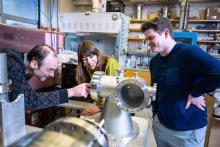It cost a modest $10 million and was only designed to be used for one year, but Canada's MOST telescope celebrates its fifth year of steady work this summer.
The suitcase-sized space telescope--launched into orbit on June 20, 2003--is a Canadian Space Agency mission led by Physics and Astronomy's Jaymie Matthews.
Originally, MOST was intended to probe the interior of stars with a technique called asteroseismology. Over time, its capacities have been extended, and researchers around the world are now also using 'the little telescope that could' to discover and explore planets beyond the solar system.
Those measurements have already turned up important results about the nature of stars, sending many theorists back to their computer screens to revise stellar models.
MOST's longevity has allowed for an additional bonus--the team at UBC is asking all Canadians to submit science proposals for the mission, with the first ideas to be released later this summer. In essence, Canadians will get to point the telescope.
The MOST team will analyze the results of the selected proposals with the winners, and publish the findings.
Musqueam First Nation land acknowledegement
We honour xwməθkwəy̓ əm (Musqueam) on whose ancestral, unceded territory UBC Vancouver is situated. UBC Science is committed to building meaningful relationships with Indigenous peoples so we can advance Reconciliation and ensure traditional ways of knowing enrich our teaching and research.
Learn more: Musqueam First Nation
Faculty of Science
Office of the Dean, Earth Sciences Building2178–2207 Main Mall
Vancouver, BC Canada
V6T 1Z4


